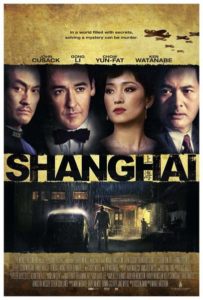Shanghai
谍海风云
US, 2010, colour, 2.35:1, 102 mins.
Director: Mikael Håfström.
Rating: 7/10.
Full-on, pulpy mystery-thriller, set in the 1940s, entertainingly tips its hat to studio classics.
Shanghai, Oct 1941. Posing as a journalist, US spy Paul Soames (John Cusack) arrives in Shanghai from his last posting in Berlin. The city is divided into sectors controlled separately by the British & Americans, the French, and the Japanese, with the last also controlling the rest of China. When his best friend (and fellow spy) Connor (Jeffrey Dean Morgan) is found murdered – and Connor’s Japanese girlfriend Sumiko (Kikuchi Rinko) disappears – Paul Soames vows to find the killer. He learns Connor was investigating Shanghai mobster Anthony Lan-ting (Zhou Runfa), who works for the Germans and Japanese, especially Japanese intelligence chief Tanaka (Watanabe Ken). He also gets to know Anthony Lan-Ting’s wife Anna (Gong Li), Connor’s undercover Japanese contact Kita (Huang Zhixian) and German spy Leni Müller (Franka Potente), all of whom may have info about Connor’s murder. He then finds out Connor was also investigating Tanaka and had made a discovery that involved Nazi Germany.
REVIEW
Short of having the Warner Brothers logo at the start, and Humphrey Bogart walk on screen and say “Play it again, Chan,” Shanghai 谍海风云 is the closest thing to an oriental version of Casablanca (1943) in colour and widescreen as you’re likely to get. The surprising thing is that it pretty much works, on its own deliberately pulpy level, and even manages to pack some genuine emotion into its final section and must-make-the-last-ship-out finale. The central plot doesn’t really manage to combine the main character’s personal and professional quests, and some interesting side characters get beached by the tight editing; but while it’s running on screen, Shanghai doesn’t bore for a second.
The technical crew is as international as the city of the title: Swedish-born genre director Mikael Håfström (Derailed, 2005; 1408, 2007) conducts the whole movie in a way that tips its hat to classic film noir but never becomes a parody; French d.p. Benoît Delhomme (1408; Cyclo, 1995) trowels on the atmosphere with smokey lighting and loads of shadow; the churning score by German/US composer Klaus Badelt (The Promise 无极, 2005) keeps the drama well stoked while not coming up with any memorable themes; Julie Weiss’ costumes look lived-in rather than pastiches; and veteran British production designer Jim Clay’s re-creation of 1940s Shanghai in Thailand and the UK (after pre-production was forced to move from China) cleverly combines an oldstyle backlot look with an immense amount of realistic detail.
The whole film – which comes in at exactly the running time of Casablanca – has the feel of one that has been ruthlessly pared in post-production. Because of either that, or the original script by Hossein Amini (The Wings of the Dove, 1997; Killshot, 2008), some interesting supporting characters get less screen time than their due: Franka Potente’s German spy, Hugh Bonneville’s cynical editor, David Morse’s US intelligence officer, just for starters. And Amini’s script lacks a genuine sense of dry humour to give some relief to the densely plotted main story and allow the characters to breathe a little beyond being genre cut-outs. John Cusack, who starred in Håfström’s paranormal thriller 1408, looks comfortable in a period suit and hat, and holds his own space against older, more physical  actors like Zhou Runfa 周润发 [Chow Yun-fat] and Watanabe Ken 渡辺谦; but the writing doesn’t give his American-in-the-Far-East character any real flavour beyond trading mildly risque quips across the dance floor with the shady vamp of Gong Li 巩俐 and Potente’s more iron-jawed German spy. Strangely, it’s only with Watanabe, as the Japanese villain, that Cusack establishes much screen chemistry – which does give the film’s ending some emotional punch.
actors like Zhou Runfa 周润发 [Chow Yun-fat] and Watanabe Ken 渡辺谦; but the writing doesn’t give his American-in-the-Far-East character any real flavour beyond trading mildly risque quips across the dance floor with the shady vamp of Gong Li 巩俐 and Potente’s more iron-jawed German spy. Strangely, it’s only with Watanabe, as the Japanese villain, that Cusack establishes much screen chemistry – which does give the film’s ending some emotional punch.
[The film premiered at the Shanghai Film Festival on 10 Jun 2010, and was released in China on 17 Jun 2010. Despite showing in many other countries, it was not released in its home territory of the US until 2 Oct 2015.]
CREDITS
Presented by Weinstein Company (US). Produced by Phoenix Pictures (US).
Script: Hossein Amini. Photography: Benoit Delhomme. Editing: Peter Boyle, Kevin Trent. Music: Klaus Badelt (piano solos: Lang Lang). Production design: Jim Clay. Art direction: Peter Francis, Oliver Roberts. Costume design: Julie Weiss. Make-up/hair design: Aileen Seaton. Sound: Nigel Mills. Second unit direction: John Greaves. Action: Vic Armstrong. Visual effects supervisor: James Madigan. Visual effects: John Bair (Guerilla FX), Angela Barson (The Moving Picture Company), Adam McInnes (The Senate VFX). Special effects: Dominic Tuohy.
Cast: John Cusack (Paul Soames), Gong Li (Anna Lan-ting), Zhou Runfa [Chow Yun-fat] (Anthony Lan-ting), Jeffrey Dean Morgan (Connor), Kikuchi Rinko (Sumiko), Franka Potente (Leni Müller), David Morse (Richard Astor), Huang Zhixian (Kita), Hugh Bonneville (Ben Sanger, editor), Watanabe Ken (Tanaka), Christopher Buchholz (Karl Müller), Wolf Kahler (German ambassador), Zhang Yin (Sanger’s mistress), Gemma Chan (Xinxin), Crystal Yu (Lili), Nicholas Rowe (Ralphie, opium addict), Ronan Vibert (Mikey, opium addict), Michael Culkin (Billy, passport forger), Selina Lo (Meiling), Huang Wanling, Huang Wanjun (cabaret performers).
Premiere: Shanghai Film Festival, 10 Jun 2010.
Release: US, 2 Oct 2015.
(Review originally published on Film Business Asia, 11 Jun 2010.)
